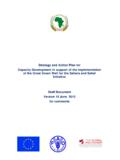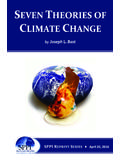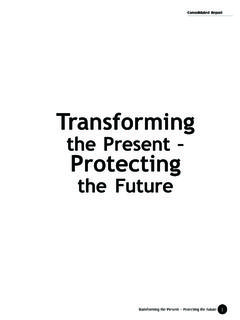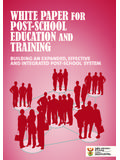Transcription of Cities and Green Growth: A Conceptual Framework
1 Cities and Green growth : A Conceptual Framework Please cite this paper as: Hammer, S. et al. (2011), Cities and Green growth : A Conceptual Framework , OECD Regional Development Working Papers 2011/08, OECD Publishing. OECD Regional Development Working Papers 2011/08 Stephen Hammer, Lamia Kamal-Chaoui, Alexis Robert and Marissa Plouin JEL Classification : O1, O3, Q1, Q2, Q3, Q4, Q5, R1, R4, R5 2 OECD REGIONAL DEVELOPMENT WORKING PAPERS This series is designed to make available to a wider readership selected studies on regional development issues prepared for use within the OECD. Authorship is usually collective, but principal authors are named. The papers are generally available only in their original language, English or French, with a summary in the other if available. The opinions expressed in these papers are the sole responsibility of the author(s) and do not necessarily reflect those of the OECD or the governments of its member countries.
2 Comment on the series is welcome, and should be sent to or the Public Governance and Territorial Development Directorate, 2, rue Andr Pascal, 75775 PARIS CEDEX 16, France. ---------------------------------------- ----------------------------------- OECD Regional Development Working Papers are published on ---------------------------------------- ----------------------------------- Applications for permission to reproduce or translate all or part of this material should be made to: OECD Publishing, or by fax +33 1 45 24 99 30. OECD 2011 3 ABSTRACT This report examines the current state of knowledge about Green growth in Cities and outlines the key research questions and protocols that will guide the OECD Green Cities programme. It builds the case for an urban Green growth agenda by examining the economic and environmental conditions that have pushed the Green growth agenda to the forefront of policy debate and assessing the critical role of Cities in advancing Green growth .
3 Section 1 lays the context for the paper, examining why Green growth is important and how it can be defined in an urban context. Section 2 focuses on policies and tools that enable the transition to Green growth in Cities . It concludes with a proposal for a policy Framework for an urban Green growth agenda that is based on a set of hypotheses of desirable economic scenarios. Section 3 examines the main challenges to advancing an urban Green growth agenda. It explores the roles that multi-level governance, measuring and monitoring tools and finance must play in delivering Green growth in Cities . The report concludes with suggestions for future research, including recommendations on how national policymakers responsible for regional and urban policies can advance an urban Green growth agenda. JEL classification: O1, O3, Q1, Q2, Q3, Q4, Q5, R1, R4, R5 Keywords: Climate, Global Warming, Sustainable Development, Government Policy, Planning, Regional, Urban, Cities , Territorial, Regional Economics, Urban Sustainability, Green growth 4 ACKNOWLEDGEMENTS This report is part of the series of OECD Working Papers on Regional Development of the OECD Public Governance and Territorial Development Directorate, directed by Joaquim Oliveira Martins, Head of the Regional Development Policy Division.
4 The report has been undertaken within the Framework of the OECD Green Cities programme of the Regional Development Policy Division. It was produced and edited by Lamia Kamal-Chaoui, Head of the OECD Urban Development Programme, Alexis Robert (Urban Policy Analyst) and Marissa Plouin (Urban Policy Analyst). The report draws on a number of internal contributions, including from Olaf Merk (urban finance), Tadashi Matsumoto (compact Cities ) and Xiao Wang (local Green growth plans). Statistical data were produced by Monica Brezzi, Head of the Statistical Analysis, Daniel Sanchez-Serra, Mario Piacentini and Konstantin Rosina. Stephen A. Hammer, PhD, Department of Urban Studies and Planning, Massachusetts Institute of Technology (MIT), provided a major contribution to this report. Special thanks are given to Jeremy Rifkin, (President, Foundation on Economic Trends), David Miller (Counsel at Aird & Berlis LLP, former Mayor of Toronto and former Chair of C40 Climate Leadership Group), Remi Dorval (Vinci Fabrique de la Cit ), Pierre-Noel Giraud (Ecole des Mines - Paris) and Fabio Grazi (Agence Fran aise de D veloppement).
5 We would also like to acknowledge those who have provided valuable comments on the report and relevant background material. In the OECD, they are Jan Corfee-Morlot, Xavier Leflaive, Chris Kennedy and Natasha Crespin (Environment Directorate); Claire Charbit and Aziza Akhmouch (Public Governance and Territorial Development Directorate). The paper has also benefitted from comments of individuals outside the OECD Secretariat, including from Alain Ayong Le Kama (French Ministry of the Environment), Dominique Bureau (French Ministry of the Environment), Paul Cheshire (London School of Economics), Ian Cochran (Caisse des D p ts et Consignations - France), Patrick Dubarle (Consultant), Graham Floater (The Climate Centre - UK), Nicky Gavron (Member of the London Assembly), Benoit Lefevre (IDDRI/Sciences-Po, Paris), Martine Liotard (Institut d Am nagement et d Urbanisme de l Ile-de-France), Barbara Norman (University of Canberra), Bert Provan (London School of Economics, formerly at the Department of Communities and Local Government - UK), Suzanne Salz (ICLEI-International Council for Local Environmental Initiatives)
6 And Dimitri Zenghelis (London School of Economics). 5 TABLE OF CONTENTS OECD REGIONAL DEVELOPMENT WORKING PAPERS .. 2 ABSTRACT .. 3 ACKNOWLEDGEMENTS .. 4 8 1. Defining Green growth in an urban context .. 11 Why Green growth ? .. 11 A concept driven by the global crisis .. 11 Global environmental and climate threats influencing the push for Green growth .. 12 The search for a new development paradigm .. 13 Defining Green growth as a blend of ideas .. 14 What is Green ? .. 14 What is growth ? .. 16 The logic of city scale action .. 18 The unique economic role of 18 Cities burdened by externalities .. 19 How Cities contribute to climate change .. 24 Vulnerabilities to environmental related calamities and climate change .. 24 Opportunities for synergies and complementarities .. 25 How do Cities approach Green growth ? .. 27 definition of urban Green growth .
7 29 Alternative Green growth scenarios .. 30 Scenario 1: Baseline - No impact .. 30 Scenario 2: Green sector growth .. 31 Scenario 3: Economic greening .. 31 Scenario 4: Multi-sector growth .. 32 Scenario 5: Sectoral displacement .. 32 Urban Green growth : the OECD definition .. 33 2. Enabling the transition to urban Green growth : policies and tools .. 34 A policy Framework for an urban Green growth agenda .. 35 Pro- growth policies .. 38 Human capital .. 38 Infrastructure development .. 41 Innovation .. 42 Greening challenges and opportunities .. 47 Energy .. 47 Mobility .. 51 Buildings .. 54 Natural Resources Management .. 59 Pollution prevention, treatment and abatement .. 63 Green Services .. 69 Main policy instruments .. 72 Regulatory authority .. 74 Public spending .. 74 Financial tools .. 75 Information and convening .. 79 6 Delivering urban Green growth through policy coherence.
8 80 3. Main challenges to advancing an Urban Green growth 89 Limits to the urban Green growth paradigm .. 90 Potential for a zero-sum game .. 90 All Cities are not equal: the baseline 90 Addressing gaps in multi-level governance .. 92 Local-national policy 92 The role of national governments in enabling the advancement of urban Green growth .. 93 Bridging the gaps .. 94 Measuring and monitoring Green growth .. 101 OECD initiatives to measure progress toward Green growth .. 103 Quantitative indicators: the metropolitan 106 Financing Green growth .. 115 Conclusion: a proposal for future research .. 121 BIBLIOGRAPHY .. 126 Tables Table 1. Environmentally focused city plans .. 29 Table 2. Green sectors and jobs .. 39 Table 3. Eco-labelled buildings often benefit from higher rental/ sales prices and occupancy rates .. 59 Table 4. Roles and policy levers available to sub-natinoal authorities in energy/climate policy.
9 73 Table 5. Green growth policy synergies .. 82 Table 6. Baseline variables .. 91 Table 7. Selected water governance gaps in the Venice-city region .. 98 Table 8. Selected governance gaps for delivering Green growth in Korean Cities .. 100 Table 9. Overview of proposed OECD Green growth 105 Table 10. OECD environmental indicators developed for regions an metropolitan areas .. 107 Table 11. High density development index in three OECD metropolitan regions .. 109 Table 12. High density development index in three OECD metropolitan regions .. 109 Table 13. growth of urban land in cores and hinterlands within the largest metropolitan area of each country .. 110 Table 14. CO2 emissions in the ten largest OECD metro-regions .. 112 Table 15. Air pollution (PM ) in the ten largest OECD metropolitan areas .. 114 Figures Figure 1. Green growth and sustainable development.
10 17 Figure 2. Urbanisation and income .. 18 Figure 3. Percent of national GDP in the 10% TL3 regions with the largest GDP .. 19 Figure 4. Incremental increases of urban areas .. 20 Figure 5. The suburbanisation process in OECD metropolitan regions .. 21 Figure 6. CO2 emissions per capita in transport and density in predominantly urban areas .. 22 7 Figure 7. Electricity consumption per capita and density in predominantly urban areas .. 23 Figure 8. The ecological footprint is highest in urban areas .. 24 Figure 9. Change in economic attractiveness and growth across OECD metropolitan regions .. 26 Figure 10. Change in economic attractiveness and pollution emission across OECD metropolitan regions .. 27 Figure 11. Economic impacts of greening policies .. 34 Figure 12. Framework for urban Green growth .. 37 Figure 13. The innovation-science link in selected Green technologies.
















